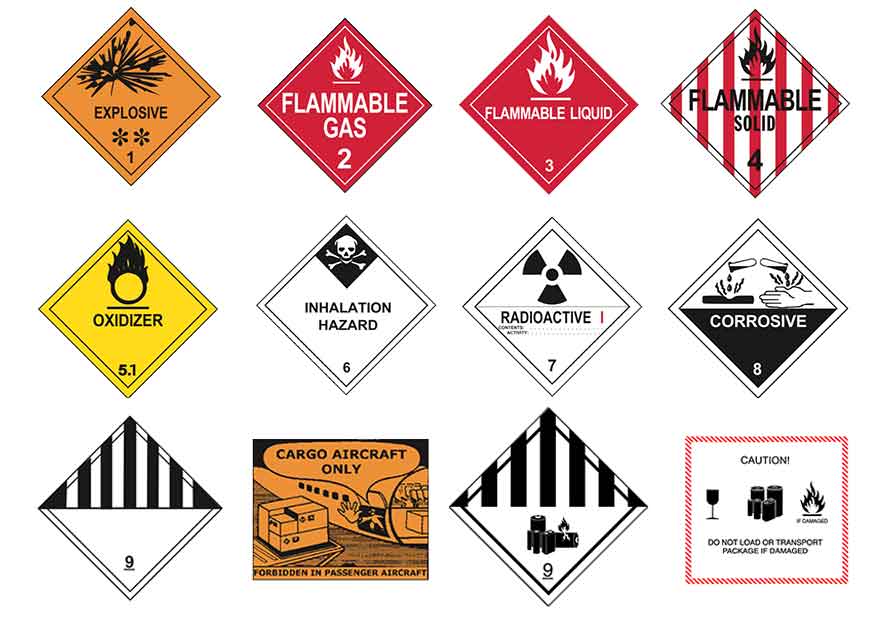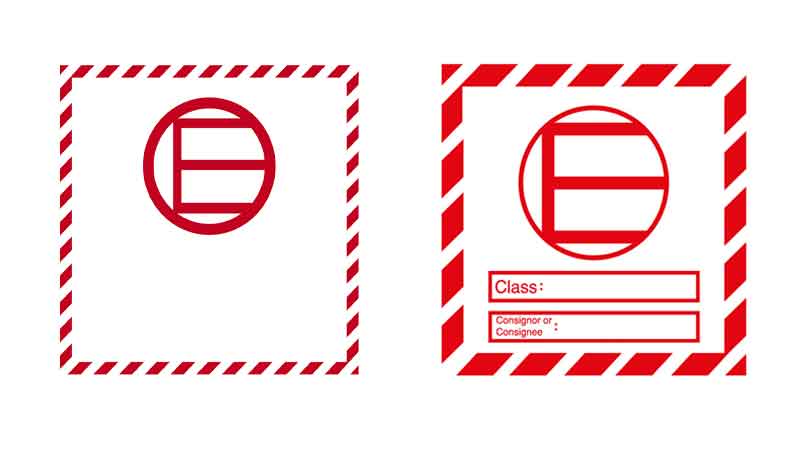Whether it’s chemicals or flammable substances, shipping dangerous goods internationally demands meticulous planning, adherence to regulations, and stringent safety measures.
The purpose of this post is to enhance your understanding of dangerous goods and provide valid strategies for seamlessly shipping hazardous materials.
Table of Contents:
- Classification of dangerous goods
- Regulations in dangerous goods shipping
- Packaging requirements for hazardous materials
- Labeling and marking of dangerous goods
- Documentation and declarations
- Tips for shipping dangerous goods internationally
- Dangerous goods excepted quantities request
- Specialized dangerous goods shipping expert
Classification of dangerous goods
Due to the inherent properties of dangerous goods (DG), they can pose risks to health, safety, or the environment during transportation. Therefore, employing special handling and packing methods is crucial based on the classification of your dangerous goods.
Typically, dangerous goods are classified into nine main classes according to the type of hazard they present during transportation. For example, Class 1 includes dynamite and fireworks, while Class 9 DG goods encompass materials like lithium batteries and magnetized items. For more detailed identification, please refer to this article.
Alternatively, you can contact our Airsupply shipping agents for guidance on identifying and classifying dangerous goods for your shipment.
Regulations in dangerous goods shipping
Here are key regulations governing the shipping of dangerous goods internationally:
The UN offers recommendations for transporting DG cargo. These serve as the foundation for various national and international regulations concerning hazardous materials shipping.
The IMDG Code furnishes guidelines ensuring the secure shipment of dangerous goods by sea. It delineates classification, packaging, labeling, and documentation requirements for shippers, carriers, and port authorities should do.
When shipping hazardous materials by air, IATA sets forth rules for safe transportation. Additionally, a valid Shipper’s Declaration of Dangerous Goods is required.
In the United States, the DOT oversees the transport of hazardous cargo in compliance with guidelines outlined in the Code of Federal Regulations (CFR) Title 49. These regulations apply irrespective of whether you are shipping dangerous goods via air, ocean, road, or railway.
Packaging of dangerous goods
The UN classifies three packing groups: I, II, and III. These groups aid in determining the necessary level of packaging required for a specific substance.
You better use the relevant UN standard package groups tailored to your dangerous cargo. For more details, you can check this official page.
Additionally, all reused packaging must undergo a thorough inspection to guarantee its ability to safeguard the new contents as effectively as the original package did.
It is imperative to avoid using single packaging. For instance, you should use additional padding for enhanced safety when shipping lithium batteries overseas.
Moreover, specific criteria apply to the inner packaging selected:
- The packaging construction should be robust, utilizing high-quality materials (including closures) capable of withstanding the contained substance inside.
- Any inner linings or barriers must provide a secure seal, effectively preventing leakage or dispersion.
- In the case of paper bags, there should be a minimum of two sheets of paper.
- Plastic bags should have a minimum thickness of 0.1mm when utilized.
Above are some key aspects to consider when packing dangerous goods. If you’re an Airsupply member, you can bypass this complex process. Our expert team can ensure your package meets the requirements for shipping hazardous materials.
Labeling and marking of dangerous goods
First, you should include the proper shipping name and United Nations (UN) number on the label to identify the substance precisely. The code generally consists of four digits and is preceded by the letter ‘UN.’ For example, the UN number for lithium-ion batteries is UN 3480.
Second, utilize standardized pictograms and hazmat shipping labels endorsed by regulatory bodies like the United Nations, IATA, IMDG Code, or national authorities. These labels need to indicate the hazard class of the substance, such as flammable, toxic, corrosive, etc.

Furthermore, some hazardous cargo may need specialized markings, such as fragile containers and items that require temperature control or additional ventilation.
To get the correct shipping label, you can send your DG cargo details to us. Our dedicated warehousing services can assist you in applying standard and necessary labels.
Documentation and declarations
Obtaining the right dangerous goods shipping document is crucial and pivotal for a seamless shipment process.
When shipping hazardous goods internationally, it’s imperative to accurately declare all dangerous materials in both your shipping papers and commercial invoice under the “Item Description.”
Additionally, several essential documents are required to facilitate smooth customs clearance at ports:
Material Safety Data Sheet (MSDS)
It is a comprehensive document providing crucial information about hazardous chemicals, substances, or materials, detailing how to work safely with dangerous goods during transportation.
Dangerous Goods Declaration (DGD)
A DGD declares the category of hazardous goods, including their UN number, proper shipping name, classification, packaging, etc. Misdeclaration or omission of information can lead to severe consequences and safety hazards.
Manifests and consignment notes
These documents provide a comprehensive list of all dangerous goods within a shipment, including their classification, quantity, and packaging details.
Emergency response information
Documents should contain instructions for handling emergencies related to dangerous goods, including contact information and procedures in case of spills, leaks, or accidents.
If an error is made on the Shipper’s Declaration for Dangerous Goods form, the shipper can correct it on the form. Then, manually write their complete signature alongside the modification.
Tips for shipping dangerous goods internationally
Compliance with basic regulations
- Familiarize yourself with IATA, IMDG Code, ADR, and specific country regulations governing the international shipping of dangerous goods.
- Utilize approved and appropriate packaging designed for the specific hazardous material being shipped.
- Ensure proper identification of hazardous goods according to their respective classes and guarantee accurate labeling and marking of packages.
Having the correct documentation
- Prepare accurate and comprehensive shipping documents, including dangerous goods manifests (DGM), DGD, and any required customs paperwork.
- Provide detailed information about the hazardous material’s nature, quantity, classification, and emergency handling procedures.
Carrier selection and notification
- Seek guidance from professional freight forwarders specializing in hazardous materials shipping to ensure compliance and best practices.
- Inform them about the nature of dangerous goods in advance to ensure smooth handling and transportation.
We at Airsupply can assist in preparing all necessary documentation to ensure compliance with specific requests.
Our personnel are always in hazmat shipping training. Therefore, we comprehend the risks associated with dangerous materials, enabling us to adopt a proactive approach toward secure and fast delivery.
Dangerous goods excepted quantities requirementst
Excepted quantities provide an alternative method for shipping small amounts of dangerous goods internationally with less stringent regulations.
Such packages may often be exempt from the marking, UN packaging, and labeling requirements specified in diverse regulations.
It’s important to note that the following marking is compulsory when shipping hazardous materials in excepted quantities, instead of the typical hazard class labeling.

The marking should display the primary hazard class or, if applicable, the material’s division.
In addition, these excepted quantities will vary based on regulations and transportation modes. Here’s an example:
UN3373 Biological Substance, Category B:
Excepted Quantity Limit (Air Transport – IATA): 30 ml or 30 g
Excepted Quantity Limit (Road Transport – ADR): 50 ml or 50 g
For more information on excepted quantities for different hazardous materials, click here.
Specialized dangerous goods shipping expert
Shipping dangerous goods safely across international borders and customs demands a comprehensive grasp of the IMDG code and awareness of any specific restrictions imposed by each country.
Fortunately, Airsupply possesses expertise and licensing to handle classes 2, 3, 5, 6, 8, and 9 of dangerous goods. We will conduct thorough risk assessments to identify potential hazards and develop mitigation strategies to minimize risks during transportation.
Moreover, we can book dangerous goods containers at competitive prices and offer transparent pricing structures.




